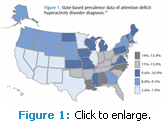
Bring Out the Best in Patients with ADHD
Follow these strategies for providing effective oral health care to children and adults with attention deficit hyperactivity disorder.
This course was published in the February 2012 issue and expires 2/28/15. The authors have no commercial conflicts of interest to disclose. This 2 credit hour self-study activity is electronically mediated.
EDUCATIONAL OBJECTIVES
After reading this course, the participant should be able to:
- Define attention deficit hyperactivity disorder (ADHD).
- Discuss the prevalence of ADHD
- List the comorbidities of ADHD
- Identify strategies for providing oral health care to patients with ADHD.
What is ADHD?
ADHD is a neurobehavioral syndrome. Symptoms include difficulty staying focused and paying attention, problems controlling behavior, and hyperactivity (over-activity). Currently, there aren’t any medical or psychological tests that provide an accurate diagnosis, but rather diagnosis depends on the presence of ADHD symptoms, ruling out other causes of the symptoms, and the use of interviews and rating scales to systematically collect information from parents and teachers about the exhibited behaviors and signs.
ADHD has three subtypes: predominantly hyperactive-impulsive (Table 1 lists symptoms), predominantly inattentive, and combined hyperactive-impulsive and inattentive. Children with the predominantly inattentive subtype are less likely to act out or have difficulties getting along with other children. They often sit quietly, but they are really not paying attention. Therefore, children with this subtype may be overlooked, thus eliminating the chance for early intervention. Combined hyperactive-impulsive and inattentive ADHD is the most common type found in children.1
Causes
|
Investigators are not sure what causes ADHD, although studies suggest that genetics play a role. Siblings of children with ADHD are five to seven times more likely to be diagnosed with ADHD than children in unaffected families. Children of a parent with ADHD have a 25% chance of developing ADHD. The identical twin of a child with ADHD has a greater than 90% chance of being diagnosed with the disorder.2-5
Like many other illnesses, ADHD probably results from a combination of factors. In addition to genetics, prenatal exposure to cigarette smoking, lead, alcohol, and cocaine; prematurity; intrauterine growth restrictions; and brain injury and infections may also play a role. ADHD is thought to be caused by problems in regulating two neurotransmitters—dopamine and norepinephrine—which may affect the ability to focus and pay attention to tasks.2-5
Prevalence
As of 2007, approximately 9.5% or 5.4 million children between the ages of 4 and 17 have been diagnosed with ADHD, with boys affected more often than girls.6,7 Between 10% and 60% of those diagnosed with ADHD in childhood will continue to meet the diagnostic criteria in adulthood. As they mature, adolescents and adults with ADHD are likely to develop coping mechanisms to compensate for their impairment, including self-medicating with smoking or illegal use of stimulants (eg, cocaine, amphetamines, Adderall, Ritalin), and consuming excessive amounts of caffeinated beverages.6-10 
The highest rates of parent-reported ADHD diagnosis are noted among children covered by Medicaid and multiracial children. Prevalence of parent-reported ADHD diagnosis vary substantially by state, from a low of 5.6% in Nevada to a high of 15.6% in North Carolina (Figure 1).11
Hispanic children are less likely than non-Hispanic white and non-Hispanic Black children to have ADHD. The strikingly low ADHD rates for Hispanic youth add to a longstanding controversy over ADHD. Uneven diagnosis patterns may reflect the broad subjectivity of this condition, which many believe is over diagnosed in some groups, particularly boys. Experts hypothesize that the low rates among Hispanic children are either related to a genetic advantage or a decision against seeking medical care for the symptoms.12 Although rates among Hispanics remained lower than non-Hispanics, Hispanic children experienced a significant increase in the number of diagnosed cases of ADHD (53%) from 2003 to 2007. This increase may signify a change in the cultural acceptance of the disorder or improved access to health care.13
|
Comorbidities
Anxiety disorders occur in approximately 25% of children with ADHD and may include separation anxiety, generalized anxiety, phobias, or obsessive compulsive disorders.8-10 Bipolar disorder occurs in as many as 10% of children with ADHD.8-10 Learning disorders affect between 10% and 40% of children with ADHD. Tic disorders, including transient, chronic, or Tourette’s syndrome, are seen in at least 6% of ADHD affected children.8-10 They are also more likely to experience problems with motor coordination that can interfere with written work in school and participation in athletic activities.8-10
More than half of adults with ADHD have a concurrent psychiatric disorder. Approximately 30% to 50% percent of individuals with ADHD have an externalizing behavior problem, such as oppositional defiant disorder. Estimates of mood disorders (depression, anxiety, bipolar disorders) vary in studies, ranging from 14% to 83%.8-10 There are reports of a link between ADHD and sleep disturbances, problems with sleep initiation, sleep maintenance, decreased REM sleep, increased periodic limb movements and awakening, and decreased daytime alertness.14-16
Treatment
Treatments can relieve many ADHD symptoms, but there is no cure. With treatment, most people with ADHD can be successful in school and lead productive lives. Current treatments focus on reducing the symptoms of ADHD and improving function. They include medication, psychotherapy, education and training, or a combination of these.
Stimulants are the most common type of medication used for treating ADHD. In children with ADHD, stimulants produce a calming effect. Different types of psychotherapy are also used to treat ADHD. Behavioral therapy aims to help children change their behavior, and can include practical assistance, such as help organizing tasks or completing schoolwork, or working through emotionally difficult events. Parents and teachers also can give positive or negative feedback in response to certain behaviors. In addition, clear rules, chore lists, and other structured routines can help children with ADHD control their behavior. Table 2 lists the methodologies used in therapy that are also relevant in the dental practice.
Oral Health
Research shows that people with ADHD are at an increased risk of caries, periodontal conditions, and bruxism associated with poor oral hygiene, increased consumption of sugary foods, and medication use.17-22 As such, it is imperative that this patient population receive regular oral health care.
The full range of dental procedures can be provided to both adults and children with ADHD.5 For children, positive reinforcement for desired behaviors and completed tasks in addition to consequences for incomplete work gradually shape a child’s behavior.20
In the dental office, children with ADHD should be given frequent breaks and provided with positive reinforcement for appropriate behavior.23 Children can be given the opportunity to earn tokens throughout the visit that can be traded in for a larger reward at the end of the visit. Children with ADHD who are taking stimulant medications may be more cooperative during visits earlier in the day. Extended release medications typically last between 8 hours and 12 hours, and may not provide coverage after school hours.24
The use of colorful and highly stimulating educational material with repeated simplified instructions during the dental visit can improve children’s self-care compliance. Follow up with parental review, focusing on brushing of teeth rather than brushing techniques and encouraging rewards for the successful completion of daily brushing.25
Children with ADHD are at increased risk of serious injury, including orofacial trauma, due to their hyperactive behavior.11 However, children with ADHD are also five to seven times more likely to be victims of physical abuse than nonaffected children.23
Dental professionals may not notice much difference in the behavior of adults with ADHD, but there are strategies for ensuring these patients have successful dental appointments.5 For example, dental appointments should be scheduled in the morning when people with ADHD are less fatigued. As with all patients, a comprehensive medical history should be taken, including a list of medications used (which may cause xerostomia) and history of illicit substance use. People with ADHD may not be able to comply fully with self-care regimens because of inattention and impulsivity.5
For both children and adults with ADHD, a prevention program such as caries management by risk assessment (CAMBRA) should be followed with an emphasis on improving salivary quality, remineralization strategies using fluoride and calcium phosphate technologies, decreasing risk factors, and increased frequency of dental prevention appointments.26
Conclusion
When faced with patients who are inattentive, restless, and noncompliant with self-care routines, ADHD should be considered as a causative factor in these behaviors.5 These patients require compassion, understanding, and creativity in determining effective oral health care strategies.5
References
- National Institute of Mental Health. Attention deficit hyperactivity disorder. Available at: www.nimh.nih.gov/health/publications/attention-deficithyperactivity-disorder/complete-index.shtml. Accessed January 18, 2012.
- Dodson W. ADHD: not just a childhood disorder. EP Magazine. 2008:38(10):74-75.
- Faraone SV. Genetics of adult attentiondeficit/hyperactivity disorder. Psychiatr Clin North Am. 2004;27:303-321.
- Biederman J, Faraone SV, Mick E, et al. High risk for attention deficit hyperactivity disorder among children of parents with childhood onset of the disorder: a pilot study. Am J Psychiatry. 1995;152:431-435.
- Friedlander AH, Yagiela JA, Mahler ME, Rubin R The pathophysiology, medical management and dental implications of adult attention-deficit/hyperactivity disorder. J Am Dent Assoc. 2007;138:475-482.
- Elia J, Ambrosini PJ, Rapoport JL. Treatment of attention-deficit-hyperactivity disorder. N Eng J Med. 1999;340:780-788.
- Gentile JP, Atiq R, Gillig PM. Diagnosis, differential diagnosis, and medication management. Psych. 2006;3:24-30.
- Biederman J, Faraone SV, Spencer T, et al. Patterns of psychiatric comorbidity, cognition, and psychosocial functioning in adults with attention deficit hyperactivity disorder. Am J Psychiatry. 1993;150:1792-1798.
- Biederman J, Wilens T, Mick E, Milberger S, Spencer TJ, Faraone SV. Psychoactive substance use disorders in adults with attention deficit hyperactivity disorder (ADHD): effects of ADHD and psychiatric comorbidity. Am J Psychiatry. 1995;152:1652-1658.
- Wilens TE. Impact of ADHD and its treatment on substance abuse in adults. J Clin Psychiatry. 2004;65(Suppl 3):38-45.
- Centers for Disease Control and Prevention. Attention-Deficit/Hyperactivity Disorder. Available at: www.cdc.gov/ncbddd/adhd/data.html. Accessed January 18, 2012.
- Wen P. ADHD rates low among Latinos. Boston Globe. Available at: http://articles.boston.com/2011-0926/news/30205138_1_adhd-medication-latino-children-latinoyoungsters. Accessed January 18, 2012.
- Centers for Disease Control and Prevention. Increasing prevalence of patent reported Attention-Deficit/hyperactive disorder among children—United States, 2003 and 2007. Available at: www.brainbalancecenters.com/wpcontent/uploads/2010/11/BBC-CDCReport-IncreaseinADHD.pdf. Accessed January 18, 2011.
- Kates N. Attention deficit disorder in adults: management in primary care. Can Fam Physician. 2005;51:53-55.
- Biederman J, Monuteaux MC, Mick E, et al. Young adult outcome of attention deficit hyperactivity disorder: a controlled 10-year follow-up study. Psychol Med. 2006;36:167-179.
- Glanzman MM, Blum NJ. Attention deficit and hyperactivity. In Batshaw ML, Pellegrino L, Roizen NJ, eds. Children with Disabilities. 6th ed. Baltimore: Brookes Publishing Co; 2008.
- Bimstein E, Wilson J, Guelmann M, Primosch R. Oral characteristics of children with attention-deficit hyperactivity. Spec Care Dentist. 2008;28:107-110.
- Blomqvist M, Ahadi S, Fernell E, Ek U, Dahllof G. Dental caries in adolescents with attention deficit hyperactivity disorder: a population-based follow-up study. Eur J Oral Sci. 2011;119:381-385.
- Blomqvist M, Holmberg K, Fernell E, Ek U, Dahllof G. Dental caries and oral health behavior of children with attention deficit hyperactivity disorder. Eur J Oral Sci. 2007;115:186-191.
- Malki GA, Zawawi KH, Melis M, Highes CV. Prevalence of bruxism in children receiving treatment for attention deficit hyperactivity disorder: a pilot study. J Clin Pediatr Dent. 2004;29:63-67.
- Chandra P, Anandakrishna L, Ray P. Caries experience and oral hygiene status of children suffering from attention deficit hyperactivity disorder. J Clin Pediatr Dent. 2009;34:25-29.
- Grooms MT, Keels MA, Roberts MW, McIver FT. Caries experience associated with attention deficit/hyperactivity disorder. J Clin Pediatr Dent. 2005;30:3-7.
- Pelham WE, Fabian G. Behavior modification. Child Adolesc Psychiatric Clin B Am. 2001;9:671-688.
- Charles JM. Dental care in children with developmental disabilities: attention deficit disorder, intellectual disabilities, and autism. J Dent Child. 2010;77:84-91.
- Waldman HB, Swerdloff M, Perlman SP. You may be treating children with mental retarding and attention deficit hyperactive disorder in your dental office. J Dent Child. 2000;67:241-245.
- Francisco EM, Azevedo S, Lyon LL, Horlak DJ, Watson PA, Young DA. Managing the risk of caries. Dimensions of Dental Hygiene. 2008;6(10):44-45.
From Dimensions of Dental Hygiene. February 2012; 10(2): 60-63.

